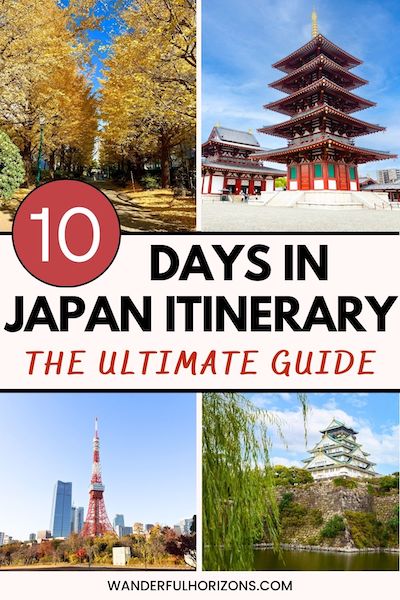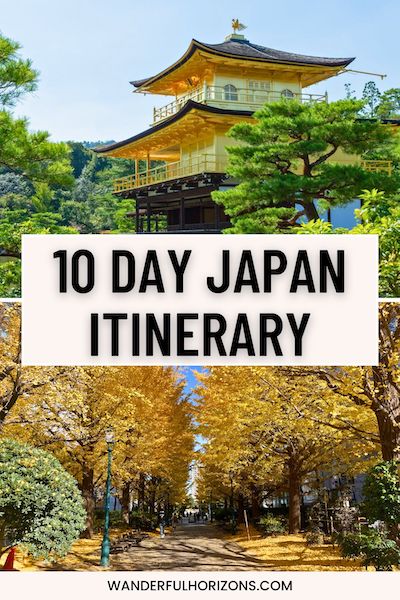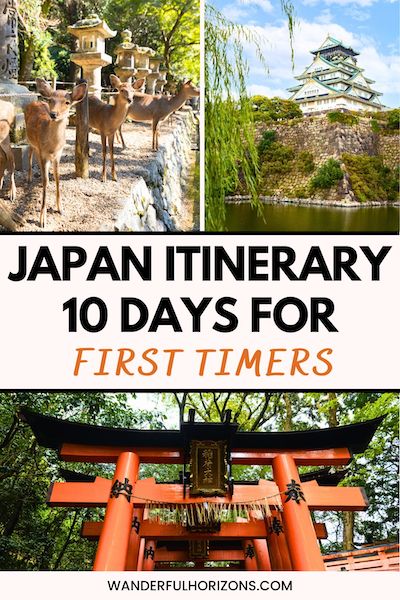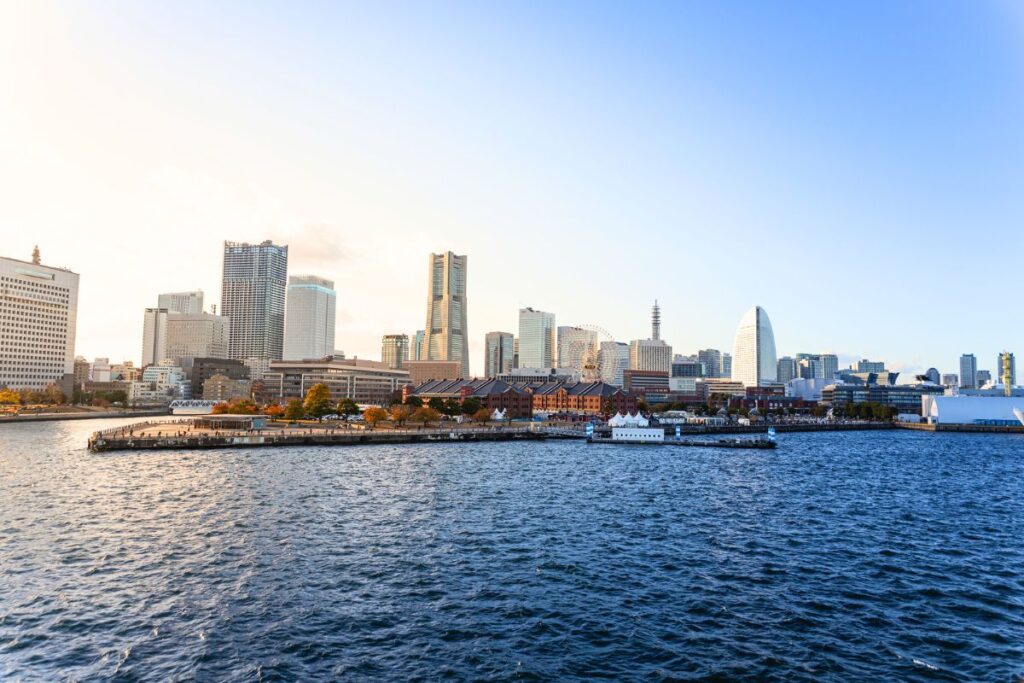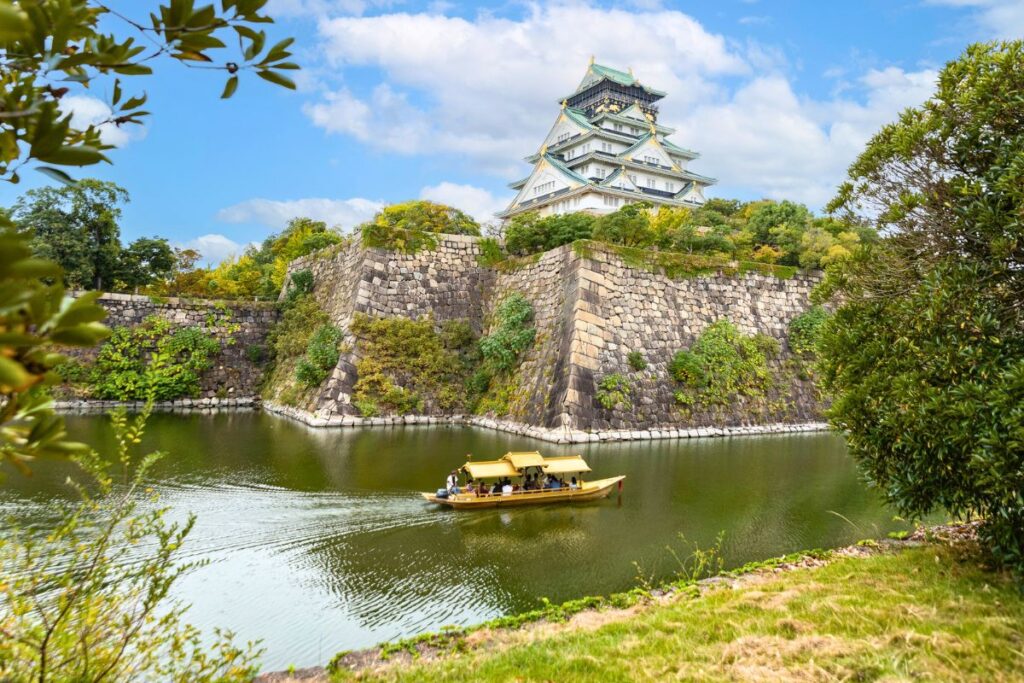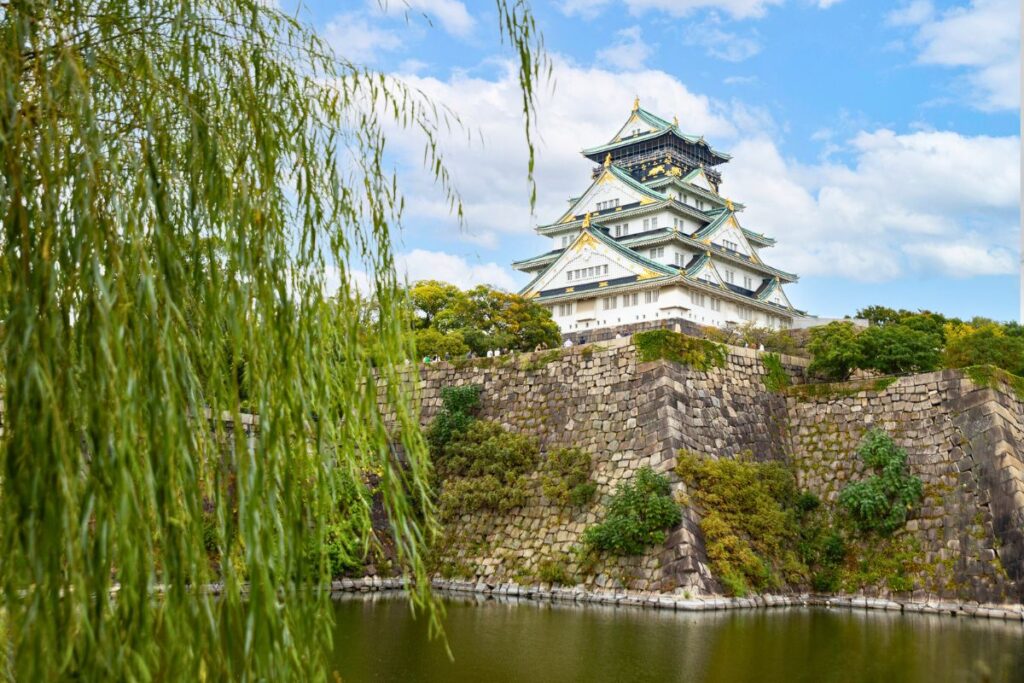
Headed to Japan for the first time? Don’t worry – I’ve got you covered with this unforgettable 10 day Japan itinerary.
Known for its rich history, vibrant culture, stunning natural scenery, and delectable cuisine, Japan is easily one of the most captivating destinations in the world.
From historic temples to futuristic skyscrapers, tranquil gardens, neon-lit streets, time-honored traditions, and cutting-edge technology, every corner of Japan offers something unique to discover.
And while exploring Japan is an experience like no other, planning your first trip here can definitely feel a little overwhelming – trust me, I’ve been there!
Luckily for you, I’m here to help!
After spending the past two years living and traveling across Japan, I’ve put together the perfect 10-day route to help you make the most of your visit.
This itinerary hits all the major highlights, while still giving you enough flexibility to soak up Japan’s charm at your own pace.
Over the next 10 days, we’ll explore the vibrant neighborhoods of Tokyo, wander through Kyoto’s iconic temples, take a day trip to Nara’s famous deer park, and wrap up with the bustling energy (and amazing food!) of Osaka.
Sound good? Then let’s dive right in and discover the perfect 10 day itinerary for Japan!
*Please note: This post contains affiliate links to trusted partners. If you make a purchase using these links, I will earn a commission at no extra cost to you. Thank you for your support!
Planning a last minute trip to Japan?
Here are a few quick recommendations for you!
I suggest booking these services and activities in advance!
🚅 Getting Around:
– Japan Rail Pass (Great option if you plan to travel beyond this itinerary)
– Individual Shin Tickets (Will likely be cheaper if you plan to follow this itinerary)
– Private Airport Transfers (For those who prefer to travel by car)
🗼 Tokyo:
– Narita Express (Express train from Narita Airport to downtown Tokyo)
– Klook Pass Greater Tokyo (Discounted pass for popular attractions within Tokyo, including Shibuya Sky, TeamLab Museums, Tokyo Tower & more!)
– Guided Tours of Mount Fuji (There are lots of options to explore!)
⛩️ Kyoto:
– Kyoto Kimono Rental Experience (Great for souvenir photos!)
– Hozugawa River Cruise (Go for a scenic boat ride through Kyoto!)
– Guided Tours of Nara (There are plenty of options to check out!)
🏯 Osaka:
– Osaka Amazing Pass (Unlimited transportation & free entry into 40 different attractions – including Osaka Castle!)
– Guided Tours of Himeji (There are lots of options to explore!)
– Guided Tours of Kobe (There are plenty of options to check out!)
Best Time to Visit Japan
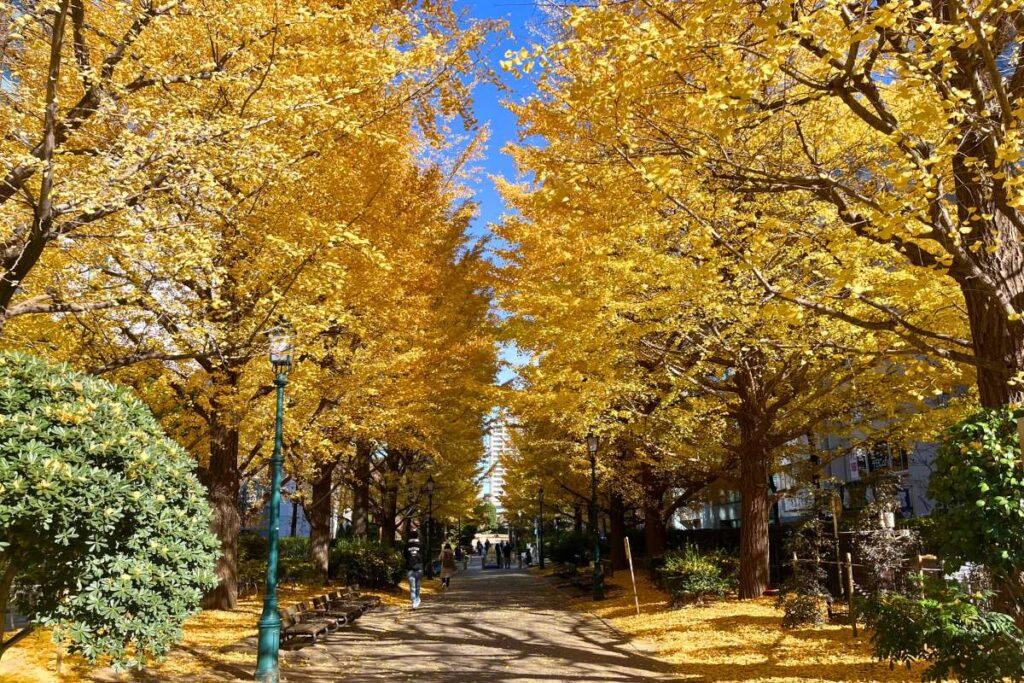
Tokyo is quite beautiful in the fall!
Generally speaking, the best time to visit Japan is either in the spring or the fall.
During both of these seasons, you’re likely to encounter mild temperatures, minimal rain, and plenty of sunshine.
That said, spring and fall are also peak travel seasons for the country. So, you should expect larger crowds and longer wait times – especially during cherry blossom season.
If you wish to avoid this, consider visiting in winter. While temperatures will certainly be colder, the country is typically less crowded and offers more affordable prices.
As an added bonus, your chances of seeing Mt. Fuji increase significantly during the winter months!
And finally, we have summer, which I honestly don’t recommend – at least not for this itinerary.
Summer in Japan is not only hot and humid, it’s also when the country experiences its rainy season. So, it’s best to avoid this, if at all possible.
Pro Tip: If you plan to visit Japan around the holidays, be sure to set aside some time to check out the local Christmas markets!
A Note on Japanese Holidays
Japan has a few major national holidays that significantly impact travel. These include Golden Week (end of April – beginning of May), Silver Week (mid-September), and New Year. Around these holiday periods, domestic travel peaks, prices increase significantly, and businesses may temporarily close down. Given this, I generally recommend that visitors avoid traveling to Japan during these times.
How to Get to Japan
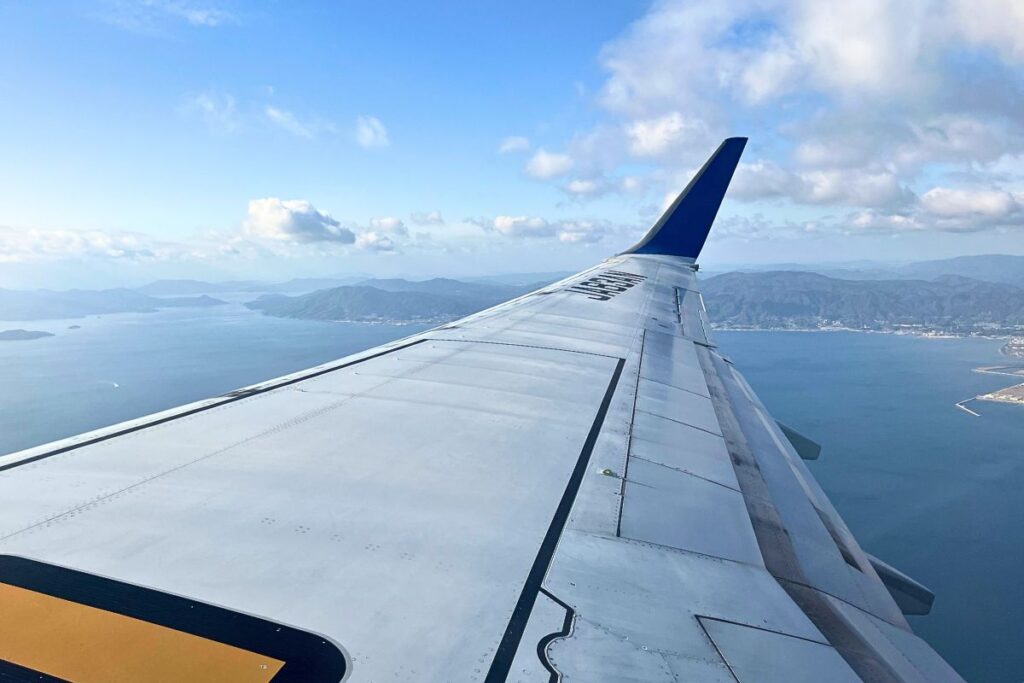
For the purposes of this Japan itinerary, you’ll want to fly into the capital city of Tokyo.
There are two international airports here for you to choose from – Haneda Airport (HND) and Narita International Airport (NRT).
Generally speaking, international flights traveling from the United States and Europe transit through Narita. While, those coming from Asia typically fly into Haneda.
Traveling From Narita Airport to Tokyo
The Narita Airport is actually located outside of Tokyo in the nearby city of Narita.
While it does take a bit longer to travel from the airport to downtown Tokyo, there are several transportation options available for you to choose from.
Here’s a quick breakdown of the most popular ways to travel into the city:
- 🚆 Narita Express (N’EX): The Narita Express offers direct service to several major stations, including Tokyo Station, Shibuya Station, and Shinjuku Station. While travel times vary depending on your destination, it takes about one hour to reach the downtown area and costs approximately 3,000 yen one way.
- 🚄 Keisei Skyliner: An alternative to the N’EX, the Keisei Skyliner is another express train that offers direct service to Nippori Station and Ueno Station in downtown Tokyo. The ride takes around 40–50 minutes and costs about 2,300 yen one way.
- 🚃 Local Train: Various local JR and Keisei lines connect Narita Airport with central Tokyo. Travel times average between 80–120 minutes, with ticket prices ranging from 1,000 to 1,500 yen each way.
- 🚌 Airport Limousine Bus: The Airport Limousine Bus offers direct service to several major train stations and hotels in the city. While travel times and prices vary depending on your final destination, it takes about 90 minutes to reach central Tokyo and costs around 3,100 yen one way.
- 🚖 Taxi or Private Transfer: Taxis and private transfers offer convenient, door-to-door service but come with a higher price. While taxis typically cost about 30,000 yen, private transfers start at around 18,000 yen and increase depending on the size of the car. Travel time to the city center takes about 90 minutes, depending on traffic.
Traveling From Haneda Airport to Tokyo
Haneda Airport, on the other hand, is located within city limits. This generally makes the journey into Tokyo quicker and more affordable.
Here’s a quick breakdown of the most popular ways to travel to downtown Tokyo:
- 🚆 Tokyo Monorail: The Tokyo Monorail offers direct service to Hamamatsucho Station, which lies just outside of the city center. Travel time takes about 15 minutes and costs around 500 yen. From here, you can transfer to the JR Yamanote Line or another local subway line to reach your final destination.
- 🚈 Keikyu Line: The Keikyu Line provides transportation to Shinagawa Station in northern Tokyo. Travel time takes about 15–20 minutes and costs 330 yen. From Shinagawa, you can easily transfer to a variety of other train lines to reach your accommodations.
- 🚌 Airport Limousine Bus: The Airport Limousine Bus provides direct service to major train stations and hotels throughout the city. Depending on your final stop, travel time ranges from 30 to 60 minutes, and tickets typically cost between 1,000 and 1,500 yen.
- 🚖 Taxi or Private Transfer: It takes about 30-40 minutes to travel to central Tokyo by taxi or private transfer. While taxis cost around 7,000–11,000 yen, private transfers usually start at around 11,000 yen and increase depending on the size of the vehicle.
How to Get Around Japan
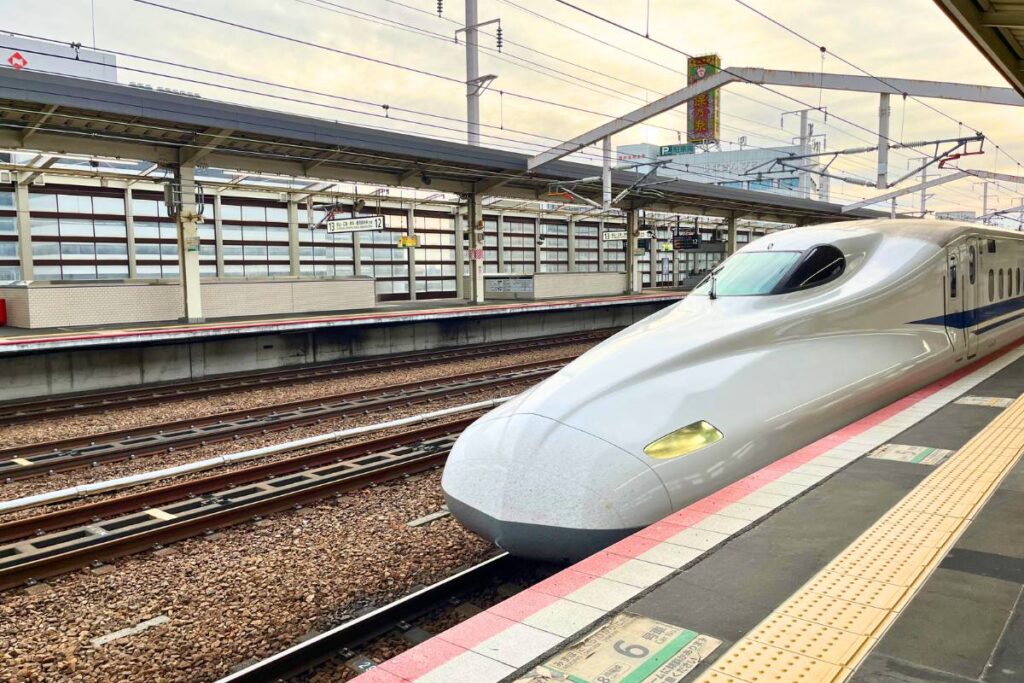
The bullet train in Japan.
Japan is known for its clean, efficient, and incredibly reliable public transportation system – making it surprisingly easy to navigate, even for first-time visitors.
Below, I’ve provided a quick breakdown of how you can get around Japan, both locally and between cities!
Traveling Within Cities
When traveling locally within cities, you’ll mostly rely on subways, buses, and occasionally trams, depending on the region.
While you can purchase individual transit tickets as you go, I recommend using an IC Card instead.
These prepaid, refillable transportation passes are valid on most forms of local transit across the country – so you only need one for your entire trip!
You can purchase them upon arrival at the airport or from any major train station.
Or, alternatively, if you have an iPhone, you can download an IC Card directly to your Apple Wallet. Unfortunately, this option isn’t available yet for Android users.
Traveling Between Cities
Meanwhile, to travel between cities, you’ll typically utilize regional trains or the Shinkansen (aka bullet train).
While you can use IC Cards to travel aboard most regional trains, they are not valid on the Shinkansen. So, you’ll need to purchase separate tickets if you plan to travel by bullet train.
You can pre-book Shin tickets online or purchase them upon arrival at the train station. Although, I do suggest booking them in advance, especially if you plan to visit during the busy season.
Pro Tip: While the Japan Rail Pass (which is a combo pass for the bullet train) is a great option for those traveling to multiples destinations, I don’t recommend it for this 10 day itinerary. Simply put, it’s much more cost-effective to purchase your tickets separately.
Map of Japan
To help you plan your trip, here’s a map overview of all the places mentioned in this 10 day Japan itinerary.
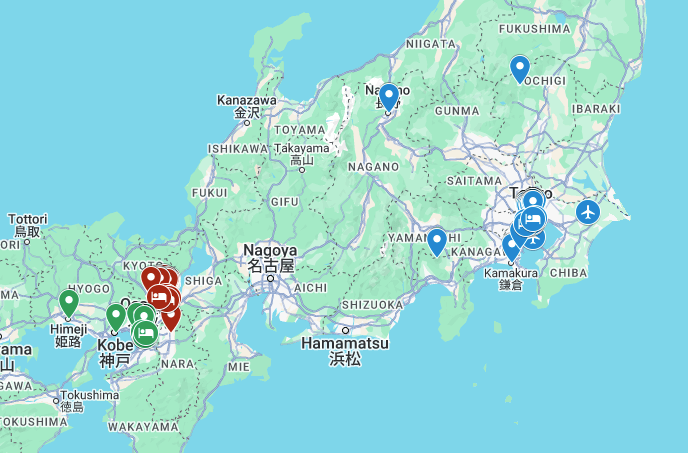
To view an interactive version of this map, click here!
10 Day Japan Travel Itinerary: An Overview
Don’t have time to read the article in full? Here’s a quick recap of my itinerary for 10 days in Japan.
- Day 1 – Tokyo: Explore Shibuya, Meiji Shrine & Shinjuku.
- Day 2 – Tokyo: Discover the neighborhoods of Asakusa, Ueno & Akihabara.
- Day 3 – Tokyo: Visit the iconic landmarks in Central Tokyo.
- Day 4 – Tokyo: Take a day trip to Mount Fuji.
- Day 5 – Kyoto: Travel to Kyoto & explore the downtown area.
- Day 6 – Kyoto: Take in the sights of Arashiyama & the Golden Pavilion.
- Day 7 – Kyoto: Discover Fushimi Inari Taisha & the Gion District.
- Day 8 – Kyoto: Take a day trip to Nara.
- Day 9 – Osaka: Travel to Osaka & spend a day visiting the city’s major highlights.
- Day 10 – Osaka: Take a day trip to Kobe or Himeji.
10 Day Japan Travel Itinerary: Explained
On that note, let’s dive right in and discuss in detail the perfect Japan itinerary for 10 days. I’ve included several activities and day tours for you to choose from. So, feel free to pick and choose and adapt this itinerary as you see fit!
Stop 1: Tokyo – 4 Days
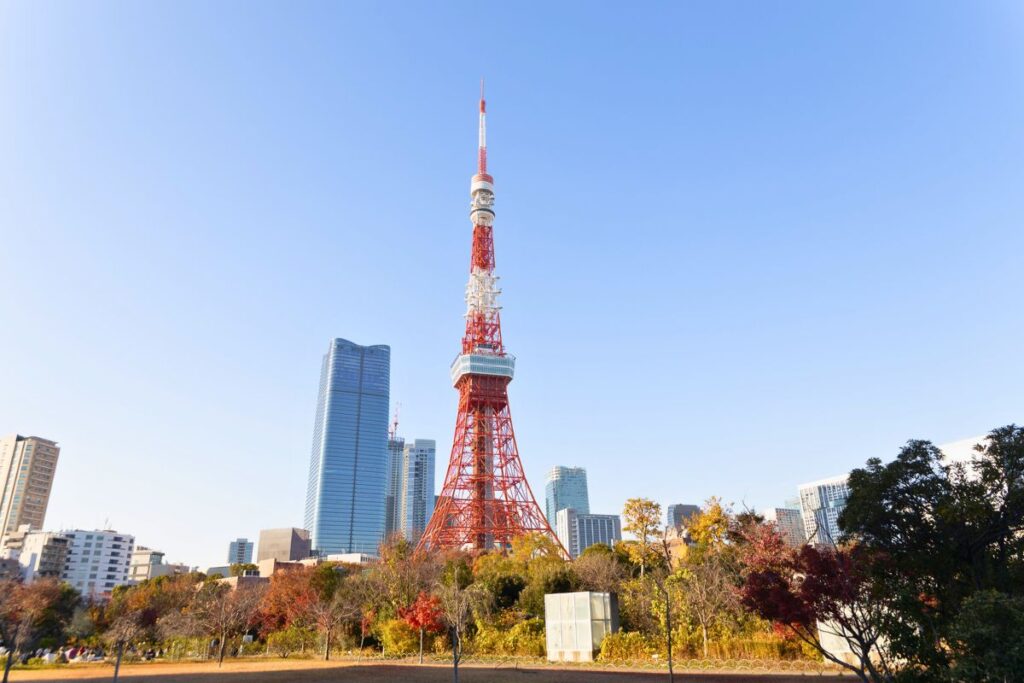
As the capital city of Japan, Tokyo is a lively and vibrant destination – one that offers a wealth of attractions and activities.
From ancient shrines and colorful temples to bustling shopping districts, expansive parks, cutting-edge museums, and buzzing nightlife, this city truly has something for everyone!
And, while you could easily spend weeks (possibly months) exploring all that Tokyo has to offer, four days should give you just enough time to get a feel for the city.
For this itinerary, I recommend spending three days exploring the city’s most popular districts. Then, on your fourth day, you can venture outside of the city on a day trip.
Best Things to Do in Tokyo
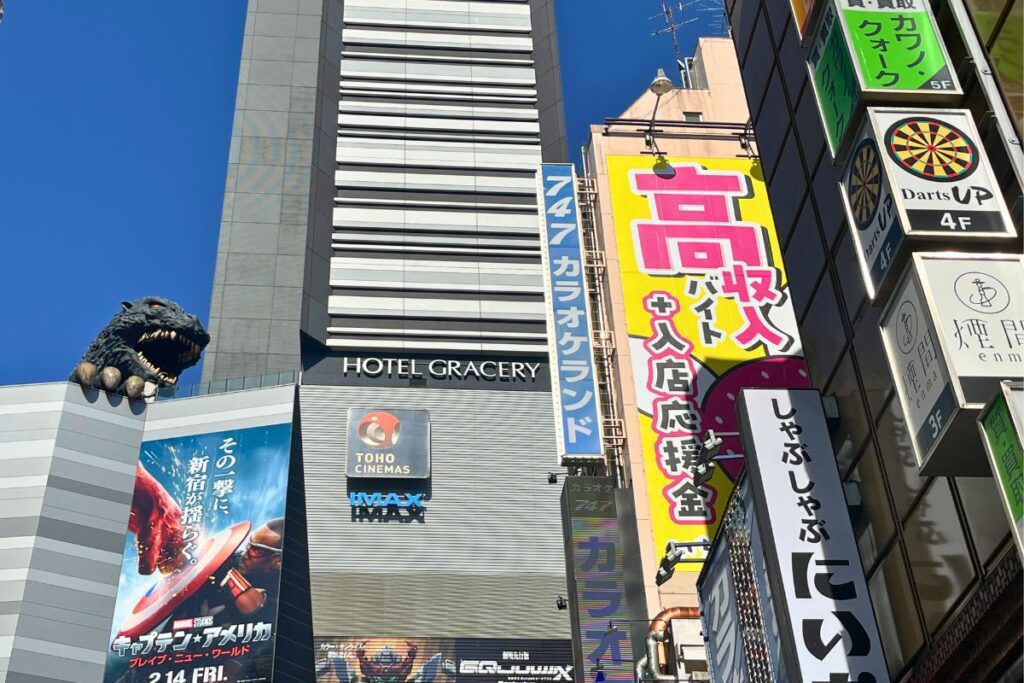
The famous Godzilla Head in Shinjuku.
Since Tokyo is quite large, I’m going to break down the attractions by area. This should make it easier for you to map out your plans for each day.
- Shinjuku: This lively district is packed with plenty of things to do. Here, you can take a peaceful stroll through the Shinjuku Gyoen National Garden, appreciate the panoramic views from the Tokyo Metropolitan Government Building, and snap a photo with the iconic Godzilla Head in Kabukicho. At night, head to Omoide Yokocho or Golden Gai for tiny alleyway bars and a unique look at Tokyo nightlife.
- Shibuya: Home to the famous Shibuya Crossing (yes, it’s as chaotic as it looks!), this area is a hub of energy and youth culture. Don’t miss the sky-high views from Shibuya Sky, pay a visit to the peaceful Meiji Shrine, and explore the nearby neighborhoods of Harajuku and Omotesando for trendy fashion and cute cafes.
- Central Tokyo: Want to mix tradition with modern flair? Central Tokyo has you covered. You can walk around the Imperial Palace, visit the tucked-away Hie Shrine, get that classic skyline view from Tokyo Tower, and sample delicious street food at the Tsukiji Outer Market. For something truly unique, visit the immersive art exhibitions at teamLab Planets or teamLab Borderless.
- Asakusa: Step back in time in Asakusa, home to Senso-ji, Tokyo’s oldest and most famous temple. Along the way, you’ll pass by Nakamise-dori, a street lined with traditional snacks and souvenirs. And if you’re up for more views, the Tokyo Skytree is just across the river!
- Ueno: If you’re into museums and parks, Ueno is your spot. Spend a couple of hours exploring Ueno Park, then check out a few of these popular museums: Tokyo National Museum, The National Museum of Nature and Science, Tokyo Metropolitan Art Museum, and/or The National Museum of Western Art.
- Akihabara: This area is a must-visit for anime, manga, and gaming lovers. Popular destinations here include Radio Kaikan, known for its collectibles; Mandarake, popular for its rare manga; and Super Potato, the go-to spot for retro games. You’ll also find giant electronics stores here packed with the latest gadgets.
- Day Trip Options: If you’re looking to explore beyond the city, Tokyo has plenty of great day trip options! Popular picks include the historic town of Kamakura, the vibrant port city of Yokohama, the stunning natural beauty of Nikko National Park, scenic spots near Mount Fuji, and the unique charm (& wildlife!) of Nagano.
Where to Stay in Tokyo
My favorite place to stay within Tokyo is in Central Tokyo – typically in Ginza or near Tokyo Station.
I find the area to be really convenient in terms of transportation, especially if you plan to take a few day trips outside of the city.
In addition to this, the area is home to numerous hotels as well as bars, restaurants, cafes, and shopping centers – which makes it an excellent option, especially for first-time visitors.
Aside from this, a few other popular places to stay in Tokyo include:
- Shinjuku: If you’d like to be in the midst of all the action, then Shinjuku is your best bet. Here, you’ll have easy access to restaurants, shopping, nightlife, and several notable attractions – all within walking distance.
- Shibuya: Home to some of the best shopping in the city, Shibuya is a great option for those in need of some retail therapy. In addition to this, the area is home to a number of trendy restaurants, bars, and cafes.
- Asakusa: Perfect for travelers seeking a more cultural experience, Asakusa (aka “Old Tokyo”) offers a relaxed, more historic atmosphere. Here, you’ll find charming local shops, traditional low-rise buildings, and a number of smaller temples and shrines, including the famous Senso-ji Temple.
- Ueno: A quieter alternative to Tokyo’s busier neighborhoods, Ueno is ideal for those looking to escape the crowds. Known for its more laid-back, local vibes, the area is home to a number of budget-friendly accommodations.
Pro Tip: Be sure to check the distance from your hotel to the subway station! As long as you stay somewhere close to a subway stop you should be fine – regardless of the area!
Stop 2: Kyoto – 4 Days
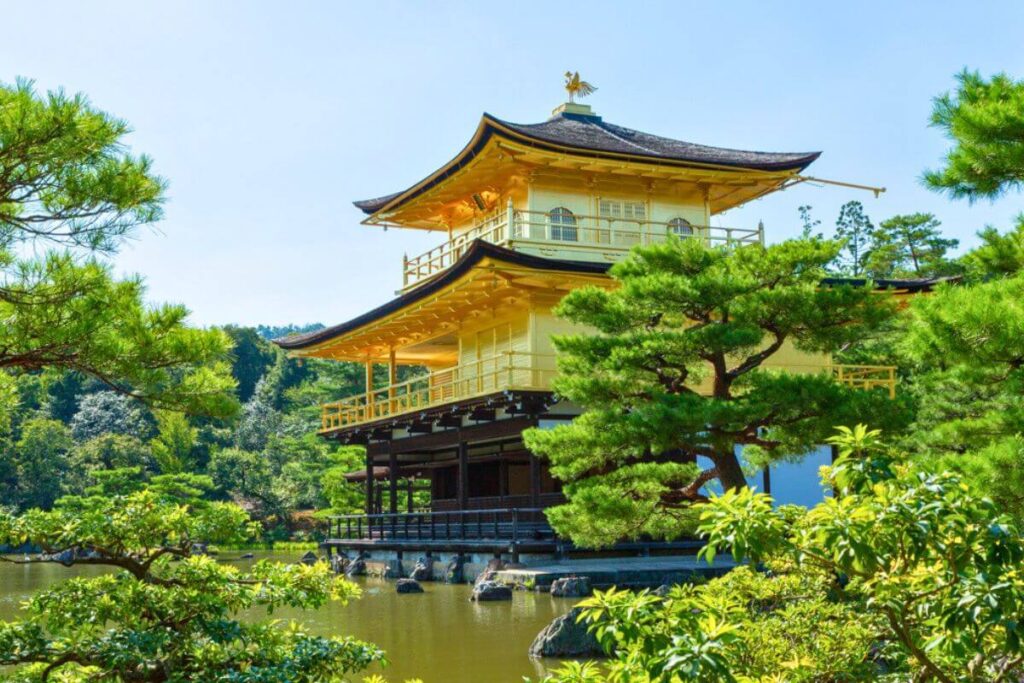
The Golden Pavilion (aka Kinkaku-ji) in Kyoto.
Known as the “City of Ten Thousand Shrines,” Kyoto is one of Japan’s most historic and culturally rich destinations.
As the former capital of the country (a position it held for over a thousand years!), the city is filled with ancient temples, sacred shrines, imperial palaces, and beautifully preserved traditional gardens.
Needless to say, there’s a lot to explore here – and you only have four days! So, it’s important to make every moment count!
For this itinerary, I recommend spending three days discovering the highlights of Kyoto. Then, on your fourth day, you can head out on a day trip to Nara!
How to Get to Kyoto
The fastest and easiest way to travel from Tokyo to Kyoto is via the Shinkansen bullet train.
You can take the Tokaido Shinkansen Line from Tokyo Station or Shinagawa Station directly to Kyoto Station.
Travel time for this varies from about 2 to 3.5 hours depending upon the specific train.
Best Things to Do in Kyoto
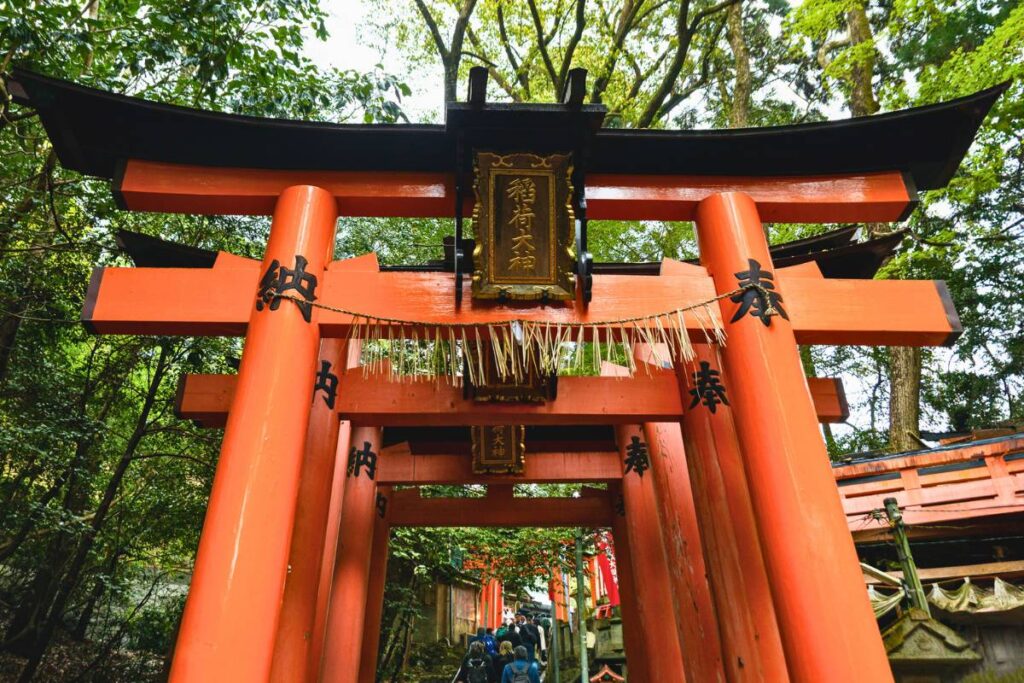
Torii gates at Fushimi Inari Taisha in Kyoto.
This list is by no means extensive, but it does highlight some of the most popular things to do in Kyoto!
- Appreciate Kyoto’s Shrines & Temples: Kyoto is home to so many temples and shrines that it would be impossible to list them all here! That aside, a few of the most notable include: the Golden Pavilion (aka Kinkaku-ji), the iconic Fushimi Inari Shrine with its endless red torii gates, and Kiyomizu-dera, which offers stunning views of the city. For a more off-the-beaten-path experience, be sure to also check out Adashino Nenbutsuji Temple and Nanzenji Temple.
- Explore the Gion District: The historical heart of Kyoto, Gion is the place to go to soak up classic old-world Japanese charm. Here, you can wander through narrow alleyways like Shimbashi Street, visit local tea houses, and appreciate the views of Yasaka Pagoda. If you’re lucky, you may even catch a glimpse of a geisha!
- Discover Kyoto’s Royal Past: As the former capital of Japan, Kyoto is home to two important imperial sites – Kyoto Imperial Palace and Nijo Castle. While the Imperial Palace served as the emperor’s official residence for more than 500 years, Nijo Castle was home to Japan’s most famous shogun (aka warlord).
- Visit Arashiyama District: Most famous for its beautiful bamboo groves, Arashiyama is the perfect nature-filled escape. Here, you can explore the Arashiyama Bamboo Forest, go for a boat ride down the Hozugawa River, and observe free-roaming monkeys at the Monkey Park Iwatayama.
- Head Out on a Day Trip to Nara: Located just 40 minutes from Kyoto, Nara is best known for its friendly, free-roaming deer (which are seriously adorable). But beyond the deer, the city is steeped in history and is home to some of Japan’s oldest and most significant cultural landmarks, including several UNESCO World Heritage Sites.
Where to Stay in Kyoto
In my opinion, the best place to stay in Kyoto is in the downtown area, right in the heart of the city.
Its central location offers easy access to many of the city’s top attractions – not to mention public transportation here is widely and readily available.
On top of that, the downtown area is packed with a variety of hotels, restaurants, cafes, shops, bars, markets (including Nishiki Market!), and lively nightlife, making it an excellent option for first-time visitors.
That said, a few other popular places to stay in Kyoto include:
- Southern Higashiyama: Encompassing the historical district of Gion, Southern Higashiyama is perfect for those looking for a more traditional Japanese experience. Here, you’ll find a variety of historic Japanese buildings, quaint shops and cafes, traditional ryokans, and several notable landmarks.
- Kyoto Station: The area around Kyoto Station is incredibly convenient if you plan to take a few day trips outside of the city. It also happens to be home to several modern shopping malls, restaurants, hotels, and nighttime venues.
- Arashiyama: Situated about 30 minutes from central Kyoto, Arashiyama is perfect for those looking for a nature-filled stay. Although it can be a bit touristy at times, the area offers convenient access to the city’s bamboo groves, peaceful rivers, and scenic landscapes.
Stop 3: Osaka – 2 Days
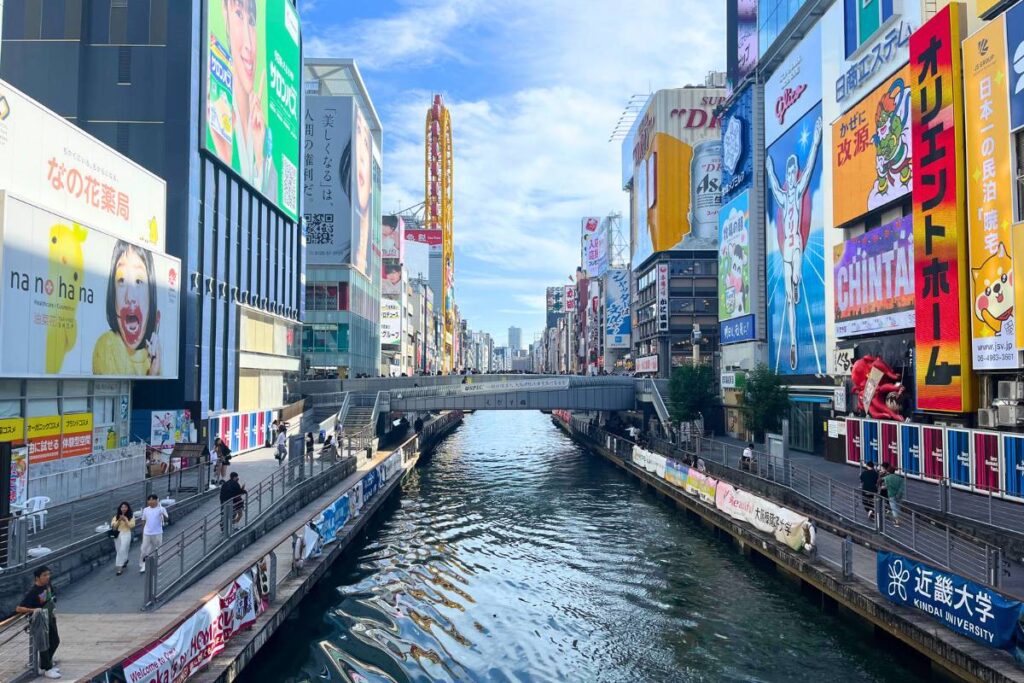
Dotonbori River in Minami District, Osaka.
The final stop on our itinerary is the lively city of Osaka, a destination known for its unique mix of culture, history, and entertainment.
Here, you’ll find iconic landmarks, bustling districts, delectable street food, and vibrant nightlife. Not to mention easy access to several nearby destinations.
It goes without saying, but there’s a lot to experience here! So, it’s important to make the most of your time.
For this itinerary, I recommend spending one day exploring Osaka’s main attractions. Then, you can head out on the second day for a quick side trip to Himeji or Kobe.
How to Get to Osaka
There are two main options for those traveling from Kyoto to Osaka: the Shinkansen (bullet train) or the special rapid service train.
Out of these two, I recommend taking the special rapid train from Kyoto Station to Osaka Station.
Not only is it more affordable, it’s still relatively fast offering travel times of about 30 minutes.
The bullet train, on the other hand, is a bit faster, traveling from Kyoto Station to Shin-Osaka Station in about 15 minutes. However, it’s much more expensive.
Unless you have the Japan Rail Pass (which, again, I don’t recommend for this particular itinerary), the extra time saved usually isn’t worth the added expense.
Best Things to Do in Osaka
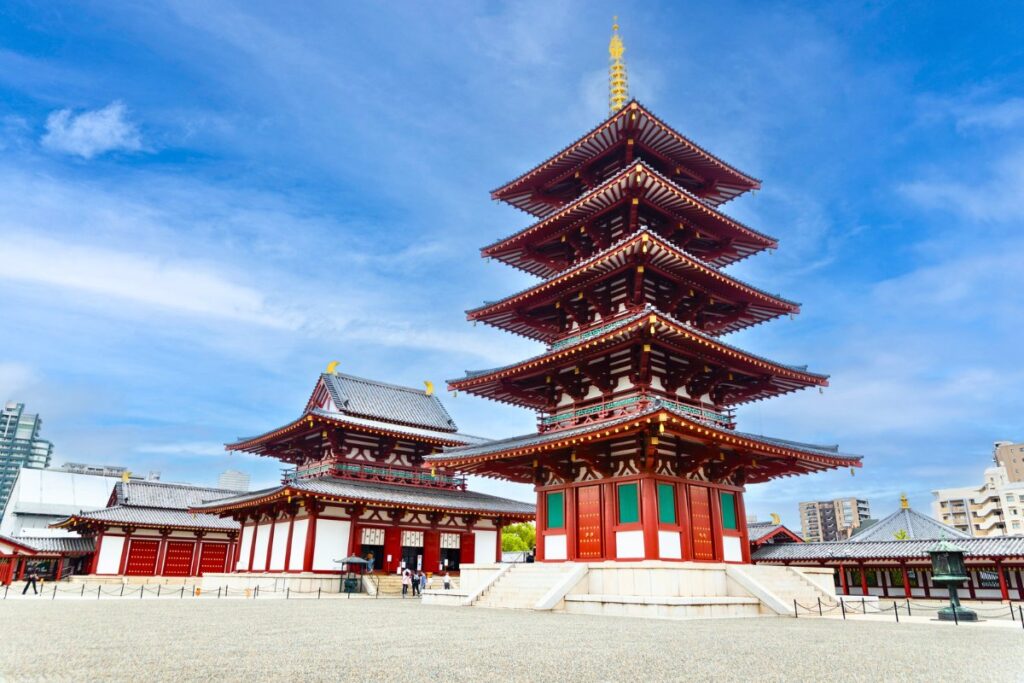
The pagoda at Shintenno-ji Temple in Osaka.
Here’s a quick look at my top recommendations for things to do in Osaka!
- Discover Historical Landmarks: Osaka is home to some fascinating historical landmarks. While Osaka Castle is undoubtedly the city’s most famous (and rightly so), another one that I’d recommend is Shinsekai “New World” District, which features the famous Tsutenkaku Tower. This nostalgic, retro district offers a unique glimpse into early 20th-century Japan.
- Explore the Minami District: Encompassing the areas of Namba, Dotonbori, and Shinsaibashi, Minami is Osaka’s top shopping and entertainment hub. Here, you’ll find a variety of shopping malls, restaurants, bars, clubs, karaoke venues, and street food vendors. The area is even home to the city’s famous lion head shrine, Namba Yasaka Shrine.
- Visit Osaka’s Shrines & Temples: Speaking of shrines, Osaka features several historic religious sites. Some of the most notable include Shintenno-ji Temple, Japan’s oldest Buddhist temple, and Sumiyoshi Taisha Shrine, which is known for its beautiful and peaceful setting.
- Indulge in Osaka’s Street Food: Osaka is often called the “Kitchen of Japan,” and for good reason – the food here is incredible! Head to Kuromon Ichiba Market to sample some of the best street food in the city. And don’t forget about Dotonbori, which is known for its abundant street food vendors.
- Venture Out on a Day Trip: Osaka offers easy access to two of my favorite cities – Himeji and Kobe. While Himeji is a small city known for its rich history and iconic castle, Kobe is a charming seaside destination celebrated for its laid-back atmosphere and incredible local cuisine. A visit to either (or both if you have extra time!) is sure to be exciting and memorable!
🌟For a more detailed guide on what to do in Osaka, be sure to check out my Osaka itinerary!
Where to Stay in Osaka
Whenever I visit Osaka, I usually stay right in the heart of the city in either Dotonbori or Namba.
Both of these areas offer easy access to a variety of bars, clubs, restaurants, cafes, shopping streets, and (most importantly!) street food vendors.
In addition, public transportation is readily available – making it quite easy to get around and explore other parts of the city.
That being said, here are a few other notable places to stay in Osaka:
- Umeda: Situated close to Osaka Station, Umeda is a convenient spot for a short trip into the city. The area, which is the main business district for Osaka, features a variety of hotels, restaurants, bars, shopping centers, and cafes.
- Tennoji Area: Located in an older part of the city, Tennoji offers affordable accommodations with more relaxed, laid-back vibes. The area is also home to a number of historical sites, local restaurants, bars, and cafes.
- Osaka Castle Area: If you’re planning to spend most of your time exploring Osaka Castle, then you might as well grab a hotel nearby. There are a number of hotels located close to the castle. And, many of them offer incredible views of the city’s most iconic landmark.
More Than 10 Days in Japan
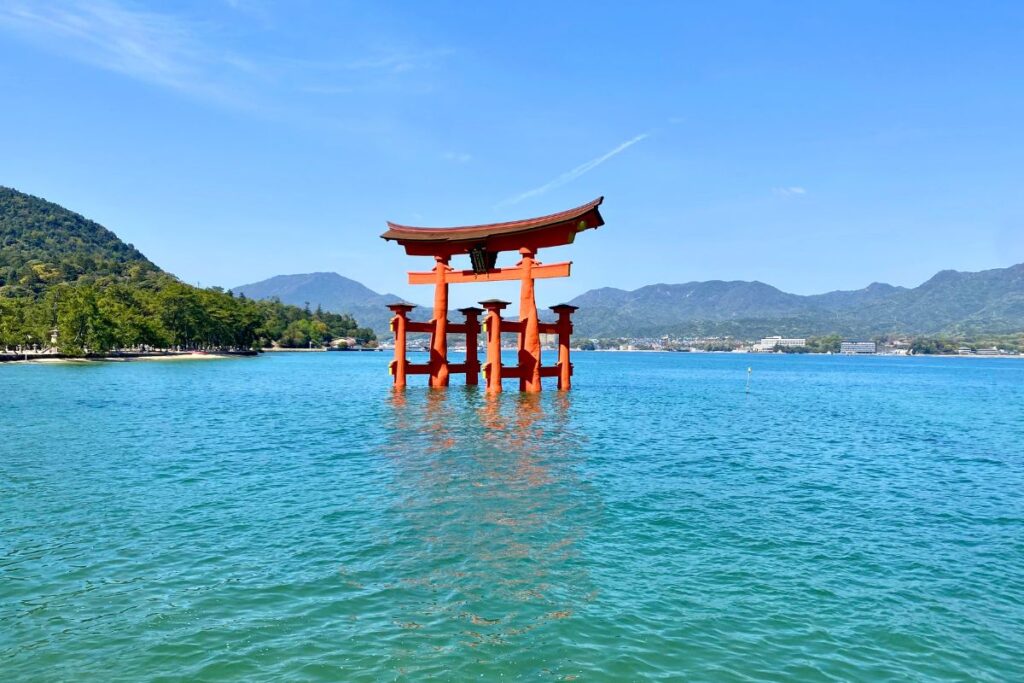
The floating torii gate near Miyajima Island.
Interested in adjusting this Japan 10 day itinerary? Or maybe you’re contemplating a longer stay? If so, consider visiting some of these other popular destinations as well!
- Hiroshima & Miyajima Island: Head south of Osaka for a few days of exploration in Hiroshima and Miyajima Island. Both destinations offer a mix of natural scenery, rich history, incredible cultural sites, and delectable local cuisine!
- Tokyo Extended: Prolong your stay in Tokyo and explore more of the city. A few additional attractions worth mentioning include the Tokyo Disney Resorts (encompassing Tokyo Disneyland and Disney Sea) and the Harry Potter Studio Tour.
- Osaka Extended: Similarly, you can extend your stay in Osaka to see more of the city and surrounding area. This is also a great option if you’re interested in visiting Universal Studios Japan.
- Kyushu: For a more off-the-beaten-path adventure, head to Kyushu. Here, you can explore the incredible southern cities of Fukuoka, Beppu, and Nagasaki!
- Okinawa: If you’d like a bit of fun in the sun, venture down to Okinawa. The islands here are home to crystal clear waters, white sandy beaches, and endless sunshine!
🌟 For more inspiration on where to go, be sure to check out my recommended destinations for first-time visitors to Japan!
Additional Tips for Your 10 Day Japan Itinerary
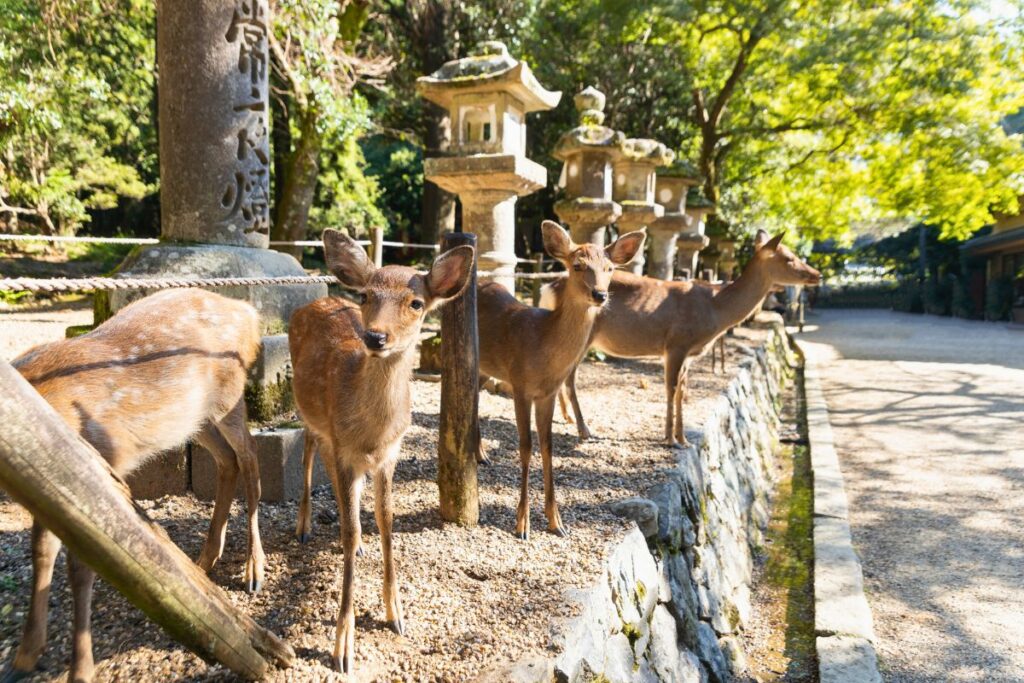
Free-roaming deer in Nara Park.
Here are a few pointers to keep in mind when planning your 10 day itinerary for Japan!
Download Google Translate – And Make It Available Offline
Unless you’re fluent in Japanese, chances are you’ll need some help navigating the language barrier. And, for that, I highly recommend Google Translate.
In my opinion, it’s one of the best apps to have in Japan, offering quick, real-time translations between English and Japanese.
You can even snap photos of signs or convenience store items, and it will translate the text for you.
Just be sure to download both the Japanese and English dictionaries for offline use. That way you have access to it no matter where you go.
Get a SIM Card or Pocket WiFi
To ensure you remain connected while traveling throughout Japan, I recommend purchasing either a SIM card, an eSIM, or a pocket Wi-Fi device.
These are all widely available at most major airports and can be obtained upon arrival.
However, it’s best to reserve them in advance – especially during the busy season – to ensure availability.
Generally speaking, pocket Wi-Fi devices are great for those traveling in groups. Meanwhile, SIM cards and eSIMS are more convenient for solo travelers.
Pro Tip: Your phone must be unlocked in order to use a SIM card or an eSIM. So, be sure to check with your carrier beforehand to confirm the status of your phone.
Book Attractions in Advance
Japan is a popular destination – which means many of its attractions book up quickly!
To avoid disappointment, I highly recommend booking tickets, tours, and time slots ahead of time, especially during peak travel season.
Attractions that are known to sell out quickly include: Shibuya Sky, Tokyo Tower, TeamLab Museums, Tokyo Sky Tree, Tokyo Disney Resorts, Universal Studios Japan, and the Harry Potter Studio Tour.
Hotels, trains, car rentals, and even popular restaurant are also known to book up quickly. So, I highly recommend pre-booking and reserving these in advance as well!
Be Sure to Carry Some Cash (Yen!)
While many major establishments in Japan now accept credit cards, you’ll still encounter smaller shops, restaurants, and attractions that are cash-only.
Given this, it’s a good idea to carry some yen with you – just in case you need it.
You can exchange money before your trip or withdraw cash upon arrival.
In fact, most convenience stores in Japan (like 7-Eleven and Family Mart) have ATMs that are foreigner-friendly. So, withdrawing cash is quick and hassle-free.
Pack Comfortable Walking Shoes
Even though Japan has an extensive public transportation system, you’ll still end up walking quite a bit – often more than you expect!
So, be sure to pack a comfortable pair of walking shoes – you’ll be glad you did.
Trust me, there’s nothing worse than traveling with sore feet!
Pro Tip: Most pharmacies in Japan sell soothing foot pads, which can be a lifesaver after a long day of walking!
Complete Your Immigration Forms Online
To expedite your entry into the country, I recommend completing your immigration and customs forms a day or two before your departure.
You can do so through Japan’s official website – Visit Japan Web.
Simply input your information and the system will generate a QR code that you can scan upon arrival at the airport.
This bypasses the need for paperwork and can save you time at Immigration and Customs.
Pro Tip: If you won’t have service when you land, be sure to screenshot your QR code. You can then save it to your photo gallery, so you can still access it while offline.
Don’t Overdo Your Itinerary
Japan has so much to offer, and while it may be tempting to try and see everything, it simply isn’t possible – and that’s okay.
Instead of cramming in too much, focus on the places and experiences that matter the most to you.
This will allow you to more fully enjoy your trip at a more relaxed pace. Plus, it’ll leave more room for spontaneous discoveries along the way.
Frequently Asked Questions About Planning a 10 Day Itinerary for Japan
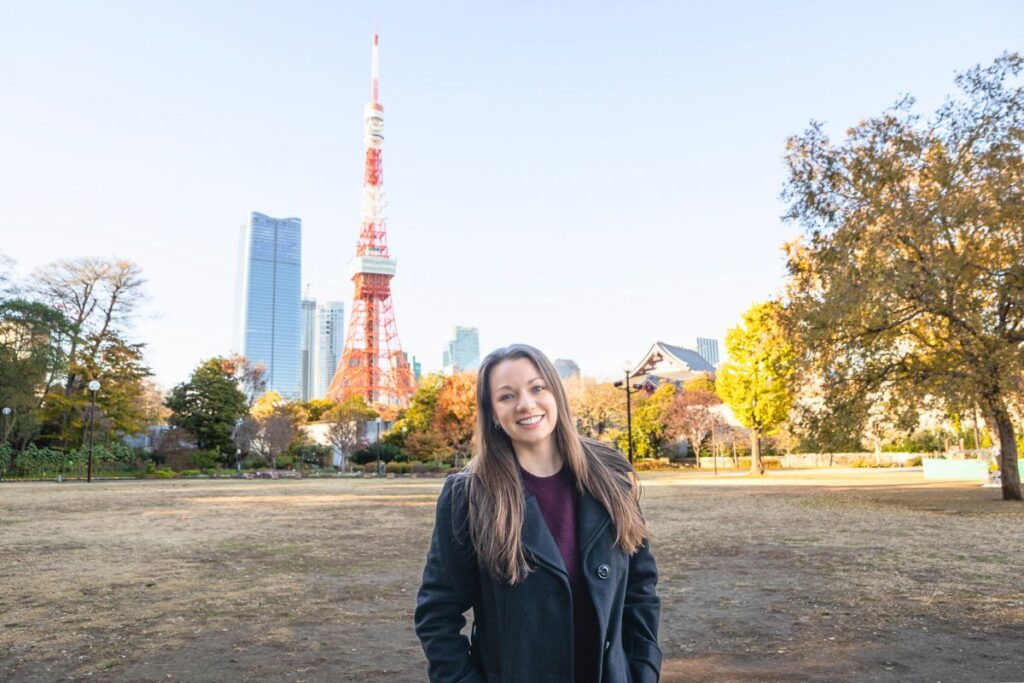
Here are my thoughts on some commonly asked questions about visiting Japan for 10 days.
Is Japan Worth Visiting?
Yes, without a doubt, Japan is absolutely worth visiting! Although I must admit, I am a bit biased in saying that, as I live here! That aside, the country has so much to offer! From ancient temples and time-honored traditions to vibrant cities, stunning landscapes, and insanely delicious food – Japan truly has something for everyone!
Is 10 Days Enough To Explore Japan?
Needless to say, it would be impossible to explore all of Japan in 10 days. But it’s definitely enough time to get a feel for the country and visit its most iconic destinations. In fact, I’d say 10 days is probably the minimum that I’d recommend for a first-time trip to Japan. Although, if I’m being honest, I think two weeks would be ideal. This would give you a little more breathing room to explore at a more relaxed pace.
Do You Need a JR Pass for 10 Days in Japan?
For this specific 10 day Japan itinerary, I don’t advise getting a Japan Rail Pass. Simply put, the pass is much more expensive than purchasing individual tickets. If you were staying longer or traveling further, it might be worth it. But, you’d really need to visit several destinations to get your money’s worth. If you’d like to calculate the costs for your own trip, you can use this Japan Rail Pass Calculator to compare prices.
How Much Does 10 Days in Japan Cost?
There’s really no clear-cut answer to this, as it largely depends on the accommodations you choose and the activities you partake in. That being said, on the lower end, I’d recommend budgeting at least $1,500 (not including flights) for a 10 day Japan itinerary. Although, I think $2,000 is probably a safer number. Of course, this cost could increase greatly if you opt to stay in fancy hotels, take private tours, or plan to do a lot of shopping.
What Is The Golden Route In Japan?
The Golden Route is a popular itinerary that many visitors follow during their first trip to Japan. Like the itinerary I’ve provided here, it includes stops in Tokyo, Kyoto, and Osaka – Japan’s three most famous cities. Some variations of the Golden Route have also been known to include Hakone, Nara, Hiroshima, and Miyajima Island.
Final Thoughts: 10 Day Japan Itinerary
So there you have it – my complete guide and recommendations for 10 days in Japan. Hopefully, this itinerary is helpful in planning your own trip to the Land of the Rising Sun.
No matter where you go or what you decide to do, you’re sure to have an incredible time. After all, Japan is a truly unique destination – one that offers unforgettable experiences and vibrant cultural encounters!!
Planning your own ten day itinerary for Japan? What are you most excited to do? Let me know in the comments below!
Enjoy this Japan ten day itinerary? Pin it now for later!
